Luigi’s Mansion 2 – Review
by Edward
|
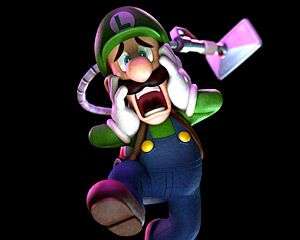 Though sales figures were poor for the fledgling console, time has been kind to the Gamecube, and despite just over twenty-million of them being sold, many of those who owned one look fondly upon it. With radical departures from the norm, the Gamecube saw a cel-shaded Zelda, a tag-team Mario Kart and a title that threw Luigi into the starring role and became one of its best-selling releases. Yet, despite its massive success and critical acclaim, Luigi once again returned to the limelight, with occasional equal-billing in the hilarious and brilliant Mario & Luigi RPGs. Twelve years after his première star-billing (no-one counts the non-Nintendo-developed 1992 Edutainment title Mario Is Missing!) Luigi once again takes centre stage and storms the 3DS with a sequel to his pseudo-ghostbusting opus.
Though sales figures were poor for the fledgling console, time has been kind to the Gamecube, and despite just over twenty-million of them being sold, many of those who owned one look fondly upon it. With radical departures from the norm, the Gamecube saw a cel-shaded Zelda, a tag-team Mario Kart and a title that threw Luigi into the starring role and became one of its best-selling releases. Yet, despite its massive success and critical acclaim, Luigi once again returned to the limelight, with occasional equal-billing in the hilarious and brilliant Mario & Luigi RPGs. Twelve years after his première star-billing (no-one counts the non-Nintendo-developed 1992 Edutainment title Mario Is Missing!) Luigi once again takes centre stage and storms the 3DS with a sequel to his pseudo-ghostbusting opus.
Luigi’s Mansion 2 (or Dark Moon, if you’re American) takes place in Evershade Valley, where the kooky Professor E. Gadd has been researching the friendly ghosts living in the area. Placated by the Dark Moon, these ghosts have no interest in spooking the locals or haunting any luxury abodes, and are content to help out the professor with his research. That is, until the Moon is destroyed by a malevolent spectre, causing the other poltergeists to freak out and start wrecking havoc. Based in a world where Venkman and company don’t exist, E. Gadd is forced to unwillingly recruit the only Ghostbuster he knows, the cowardly and reluctant Luigi. Soon reunited with his trusty Poltergust, the lanky plumber is sent out to clean house(s) and rebuild the Dark Moon before the crazed spectres leave the valley and cause mayhem throughout the Mushroom Kingdom.
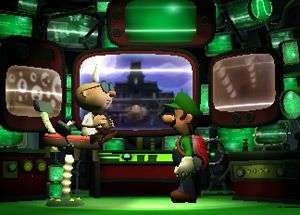 With twelve years having passed since the original, there are several key differences between the Gamecube launch title and its successor. One of the first major alterations is to the structure, as instead of the action continuously taking place in a singular mansion, the action is split up into several missions spread across multiple locations. Though at first this seems like a compromise to make the action more portable-friendly, it soon makes the action far more pick-up-and-play than the original. I found most missions typically lasting from twenty to thirty minutes – with that time being shortened significantly during replays – meaning that while they’re perfect for playing on the move they’re still just on the right side of that “one more go” mentality.
With twelve years having passed since the original, there are several key differences between the Gamecube launch title and its successor. One of the first major alterations is to the structure, as instead of the action continuously taking place in a singular mansion, the action is split up into several missions spread across multiple locations. Though at first this seems like a compromise to make the action more portable-friendly, it soon makes the action far more pick-up-and-play than the original. I found most missions typically lasting from twenty to thirty minutes – with that time being shortened significantly during replays – meaning that while they’re perfect for playing on the move they’re still just on the right side of that “one more go” mentality.
Building on that addictive tone are the rankings, which make their return and judge Luigi on the time he completed each mission, how little health he lost and the amount of treasure accumulated. Based on your performance, a one to three star ranking is then bestowed and can then be improved on in subsequent attempts, and the results screen will alter to reflect this, showing where you’ve bettered yourself and where you could stand to boost your final score.
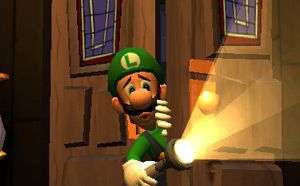 The best way to do this is through treasure, though it isn’t quite the be-all and end-all that it was before. In the original, the mansion that Luigi would be left with and the rank the player was ultimately bestowed with came down to how much money players had accrued during the night, with the best ranking a distant pipe-dream for those who failed to search every nook and cranny and experiment as wildly as possible. That’s not necessarily the case this time around, as while treasure is important for determining your mission ranking and is just as hidden as before, the other imperative for collecting treasure is to level up your equipment.
The best way to do this is through treasure, though it isn’t quite the be-all and end-all that it was before. In the original, the mansion that Luigi would be left with and the rank the player was ultimately bestowed with came down to how much money players had accrued during the night, with the best ranking a distant pipe-dream for those who failed to search every nook and cranny and experiment as wildly as possible. That’s not necessarily the case this time around, as while treasure is important for determining your mission ranking and is just as hidden as before, the other imperative for collecting treasure is to level up your equipment.
In lieu of the elemental medallions and the Game Boy Horror, Luigi will instead come across and be given a Dark-Light beam and an E. Gadd-customized Dual Scream. While the latter performs similar map-providing duties as its Game Boy Horror predecessor – as well as emitting a funky de-make jingle based on the main theme of the previous iteration in the series – it’s the Dark-Light beam that helps set this sequel apart. Each location is swarming with Boos, and each of these Boos have the ability to cause illusions, making objects in the environment disappear and often impeding Luigi’s progress as a result. The Dark-Light beam can reveal these objects and unveil the illusion orbs that are hiding it, and once those orbs are all sucked up in the Poltergust then the spell will be broken and the player can move on. However, the Dark-Light beam can only be used for a certain amount of time before it overheats, and this is where your treasure comes in.
 |
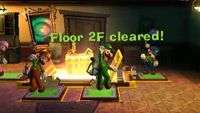 |
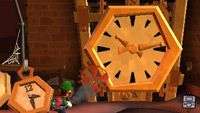 |
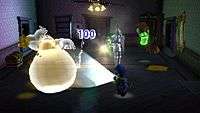 |
 |
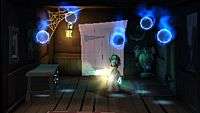 |
After acquiring a certain amount of moolah, E. Gadd can upgrade Luigi’s equipment to make his ghost-busting exploits that little bit easier, with the Poltergust and the Dark-Light beam both becoming more powerful as an offset. While the Dark-Light Beam gains a larger meter, allowing it to last longer without overheating, it’s the Poltergust that really comes into its own as a result of levelling up. As before, ghosts need to be stunned before Luigi can suck them up in his trustworthy vacuum cleaner, but this is where the similarities end. This time around, when something’s in the grasp of the Poltergust a meter will fill up, and the more players pull away from the opposing force the quicker it will fill up, allowing players to press the ‘A’ button to give the cleaner a boost in power. At first, this is mainly used to finish sucking up anything stuck in the nozzle – mostly pieces of the environment – as well as snatch up the last few hit-points of any spectre in your grasp to provide a finishing blow (well, suck).
 Once the Poltergust has been levelled up the meter begins to fragment, with each completed segment sucking up more health and providing a greater monetary bonus, meaning that the challenge then becomes going double or nothing on your foes; finishing them off while a section of the meter is filling up and you receive nothing for your troubles, but filling it up will see you picking up some gold bars. With any reward increased if Luigi snatches up several ghosts at the same time, the action often descends into risk versus reward, and it’s these moments where the gameplay feels the most rewarding.
Once the Poltergust has been levelled up the meter begins to fragment, with each completed segment sucking up more health and providing a greater monetary bonus, meaning that the challenge then becomes going double or nothing on your foes; finishing them off while a section of the meter is filling up and you receive nothing for your troubles, but filling it up will see you picking up some gold bars. With any reward increased if Luigi snatches up several ghosts at the same time, the action often descends into risk versus reward, and it’s these moments where the gameplay feels the most rewarding.
With the meter eventually requiring players to fill up three bars to get the optimum reward and enemies becoming tougher to take down the action soon becomes a frantic scramble to take down the multitude of foes ahead and garner the most treasure possible for doing so.
This challenge is bolstered by the variety of ghouls you’ll be expected to take down, from the standard Greenies to the strong-armed Slammers, the aptly named Hiders who position themselves in the scenery to jump out at Luigi to the food-spewing Gobbers and the Mario franchise mainstays known as the Boos. These are only a fraction of the enemies you’ll come up against throughout your ghost-busting exploits, and working out how best to take them down isn’t the hardest part – that’ll be trying to make your way out of a locked room with a variety of enemies waiting to eliminate you. These enemies will eventually become stronger, greater in number and tougher to deal with, and that’s before some of them start donning protection, forcing you to get cerebral to find another way to stun them before Luigi can start dispatching them.
While Luigi is equipped with a torch, stunning foes is no longer a matter of shining it on them, as the 3DS as standard lacks a second control stick, meaning that free movement with the torch isn’t possible. Instead, Luigi’s torch is given a strobe function that can be charged up to increase the radius of light, allowing multiple ghosts to be stunned at once. With one or two ghosts, the level of charge is a simple decision, but when pared off against a whole room of spectral foes players are again forced into a risk or reward decision. It may be easiest to snap up the most immediate threats, but only stunning one target may leave you vulnerable to attack from the ghosts not incapacitated by the strobe effect. Meanwhile, trying to catch several foes at once may leave you equally vulnerable as you may become unable to deal with the strays. Couple this with the fact you’re rewarded with more money for capturing several ghosts at once and Luigi’s Mansion 2 becomes an altogether more frantic and strategic affair than the original, constantly keeping players on their toes and forcing them to think on their feet to reap the greatest benefits.
 While the strobe does eventually become a natural fit and improves the gameplay more than the torch originally did, it does betray a slight issue with the controls that while never overtaking the experience or weakening it does sit in the back of the mind for longer than it is comfortable. Though I never had any issues controlling Luigi, and it didn’t take too long to adjust to the shift in controls, there were sometimes moments where I would have felt more at ease being able to move the direction of the strobe or the vacuum once they had started.
While the strobe does eventually become a natural fit and improves the gameplay more than the torch originally did, it does betray a slight issue with the controls that while never overtaking the experience or weakening it does sit in the back of the mind for longer than it is comfortable. Though I never had any issues controlling Luigi, and it didn’t take too long to adjust to the shift in controls, there were sometimes moments where I would have felt more at ease being able to move the direction of the strobe or the vacuum once they had started.
It’s possible to slightly move the direction of the vacuum with the accelerometers built into the 3DS, but the difference is so slight that you’ll rarely use or rely on it. Despite that niggling feeling for series veterans, the controls are never frustrating or finicky and the compromises put in place are effective without skewing the difficulty, meaning that while there are moments of doubt the controls make sure that Luigi’s Mansion 2 works excellently on a portable platform.
Similarly impressive are the graphics, which manage to keep the charm and personality of its predecessor and often surpass them, mostly thanks to the wider variety of locales that aren’t just confined to different kinds of Mansions. The 3D effect also does a great job of enhancing the visuals and giving everything greater definition, though gameplay isn’t affected by its presence or lack of. What Luigi’s Mansion 2 does lack is an iconic soundtrack, as while the music present is great, I never found anything as memorable as the ever-present theme permeated throughout the original. In fact, the music that stuck in my head the most was the Dual Scream’s ringtone – a remix of the original’s theme. Though there are some great little touches in the soundtrack – most notably Luigi once again humming the music – I’d be hard-pressed to remember any of them, and it’s one of the few areas where Luigi’s Mansion 2 threatens to underwhelm.
 Where it utterly fails to do that is in its length; my final save file clocked in at around sixteen hours – well over twice the amount of time it took me to complete its Gamecube ancestor – and throughout that time I never felt like it was outstaying its welcome. A major reason for this was down to the mission structure that always made you feel like you were making progress, as well as the way it would often vary tasks so that you weren’t just vacuuming ghosts the entire time. Missions would often task you with searching a completely different area to the previous mission, hunting down a certain type of ghost or rescuing the Toads that have got themselves trapped while helping E. Gadd out with his research.
Where it utterly fails to do that is in its length; my final save file clocked in at around sixteen hours – well over twice the amount of time it took me to complete its Gamecube ancestor – and throughout that time I never felt like it was outstaying its welcome. A major reason for this was down to the mission structure that always made you feel like you were making progress, as well as the way it would often vary tasks so that you weren’t just vacuuming ghosts the entire time. Missions would often task you with searching a completely different area to the previous mission, hunting down a certain type of ghost or rescuing the Toads that have got themselves trapped while helping E. Gadd out with his research.
Just completing the missions won’t let you see everything, as each location contains a bonus mission that unlocks after all the Boos there have been captured, and times Luigi on how quickly he can mop up his spectral foes. As well as the Boos, every setting has a variety of gems scattered about for Luigi to hunt down, and there’s always the illusive lure of achieving a three-star ranking on every level for the ultra-completionists.
Luigi’s Mansion 2 isn’t just a solo journey, as there’s also a non-story multiplayer mode known as the Thrill Tower (or Scarescraper if you’re American) that can be played online, locally or through download play. The Thrill Tower contains three modes: Hunter, Polterpup and Rush. Hunter sees the players aiming to eliminate all of the ghosts on each floor before time runs out, Polterpup asks players to hunt down all of the elusive ghostly canines to a time limit, and Rush gives the Luigis only a handful of seconds to find the vault that unlocks the next floor before it’s too late. Each floor is randomised, and while you’ll often see the same room types cropping up, the layout and their importance will be varied each time you see them, and every fifth level mixes up the formula or asks you to take down a boss ghost before time runs out.
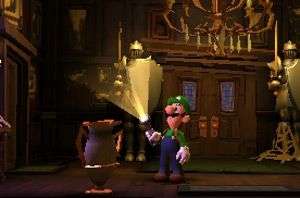 Once a floor has been cleared then Red Coins will be scattered throughout the floor and a race to collect them all will begin. There’s an advantage to being competitive about this, as if all the coins have been collected then a roulette will begin, with the winner being given a bonus item for the next floor to aid their ghost-busting quest. Collecting more coins than your partners gives you a greater chance of being given the bonus, which varies from a complete map of the entire floor and a pair of googles that highlight any objects waiting to be recovered by the Dark-Light beam, to a boost in vacuum power or the ability to recover health every time you take down a ghost.
Once a floor has been cleared then Red Coins will be scattered throughout the floor and a race to collect them all will begin. There’s an advantage to being competitive about this, as if all the coins have been collected then a roulette will begin, with the winner being given a bonus item for the next floor to aid their ghost-busting quest. Collecting more coins than your partners gives you a greater chance of being given the bonus, which varies from a complete map of the entire floor and a pair of googles that highlight any objects waiting to be recovered by the Dark-Light beam, to a boost in vacuum power or the ability to recover health every time you take down a ghost.
Unfortunately, apart from the Hunter mode, the multiplayer isn’t as unique or fun as you’d expect from a Nintendo title, with it mostly feeling like more Luigi’s Mansion but with a couple of extra people attached. The biggest issue is that there’s just not enough variety to the proceedings, and after a while you’ll have seen everything the multiplayer has to offer. Polterpup eventually becomes a more drawn-out version of Hunter mode, and Rush ends up becoming a frustrating affair that often descends into pure luck as to whether players will succeed or not. With only half a minute on the clock in the first place, players can extend the timer by ridding rooms of ghosts or interacting with objects in the environment, but whether you’ll actually receive the time bonus is completely random. What’s worse is that the mode encourages players to divide and conquer but lays out traps that may as well trigger an instant failure, as the timer will often run out in the time it takes for another player to arrive and free them. While there’s rhyme and reason to the Hunter and Polterpup modes, Rush eventually becomes a frustrating luck-based mission, and ends up feeling like a poorly-thought and unnecessary addition, but it isn’t the only thing that can feel a bit superfluous.
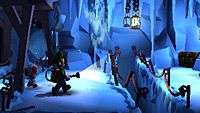 |
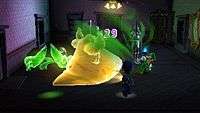 |
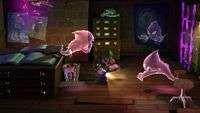 |
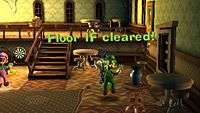 |
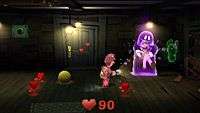 |
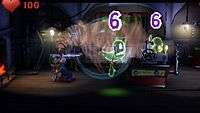 |
The aforementioned gems scattered about each single-player locale – while cleverly hidden and often fun to hunt down – also feel a bit disposable, as there’s no discernible bonus for hunting them down and my mission ranking never seemed to be affected by whether I picked them up or not. Similarly, aside from the bragging rights, there’s no real incentive to aim for three-star rankings in every level, as the bonus levels are only bestowed to those who collected every Boo, not those who’ve collected every gem or garnered the highest score. Granted, there’s the impetus to gather more money to upgrade your equipment, but I ran out of upgrades to unlock soon after I’d beaten the third boss, meaning that my skill-set had plateaued with two locations to go. While I’d have liked more upgrades, I’d also have appreciated more tools for Luigi to utilise, as once you’re given the strobe and Dark-Light beam early in the story you’re never handed a new piece of equipment. It’s best to reiterate that I never found the gameplay becoming stagnant or boring, but just one extra tool at Luigi’s disposal or a return of the elemental medallions could have open up even more possibilities in terms of gameplay.
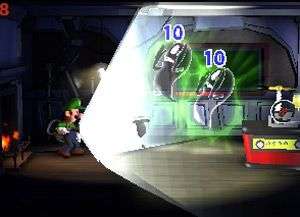 Where the gameplay opens up the most is through the Boss battles. While these conflicts in other titles normally end up just becoming tiresome obstacles or health-sponges, Luigi’s Mansions toughest spectres are a joy to fight, owing to the fact that a serious amount of effort seems to have been put in. All but one of the battles feel wholly unique and require players to take a different approach than they have done so far, with all of the boss levels from the Clock Tower onwards making up my favourite moments of the single-player. All told, they do a tremendous job of rounding out the story mode and are massively fun to play, though it can be conceded that the bosses sometimes lack the personality that the rest of this title has in spades.
Where the gameplay opens up the most is through the Boss battles. While these conflicts in other titles normally end up just becoming tiresome obstacles or health-sponges, Luigi’s Mansions toughest spectres are a joy to fight, owing to the fact that a serious amount of effort seems to have been put in. All but one of the battles feel wholly unique and require players to take a different approach than they have done so far, with all of the boss levels from the Clock Tower onwards making up my favourite moments of the single-player. All told, they do a tremendous job of rounding out the story mode and are massively fun to play, though it can be conceded that the bosses sometimes lack the personality that the rest of this title has in spades.
And from the way Luigi grabs his hat as he’s about to be teleported to his next mission to the way he calms down a panicking Toad, or the way that Gadd never quite manages to alleviate the lanky plumber’s fears, there’s plenty to keep you smiling on top of the excellent gameplay. Granted, while the soundtrack is unlikely to permeate your brain and leave you subconsciously humming it years after release, and while the multiplayer soon feels like a superficial addition rather than a vital component, there’s a lot to love about Luigi’s Mansion 2. It may have taken a long time for Luigi to return to the spotlight, but it’s been worth the wait.
Pros- Looks that often surpass its predecessor thanks to a wider variety of locales and 3D
- Oozing with personality and humour
- Risk versus reward gameplay gives a persistently frantic feel to proceedings
- Excellent Boss battles that form some of the title's greatest moments
- Lengthy game that remains consistently varied and never outstays its welcome
- Has that "one more level" vibe that keeps you playing until the early hours of the morning
- Controls do an amazing job of compensating for the lack of a second control stick...
- ...Although they leave a persistent niggling feeling
- Soundtrack is ultimately forgettable
- Could have done with more upgrades or an extra tool to spice things up in later levels
- Multiplayer fails to make its mark, with one mode descending into a luck-based mission
- No incentive to collect everything and achieve the highest rankings other than bragging rights
From picking up the Poltergust 5000 to the moment the credits roll, Luigi's Mansion 2 is more than a worthy successor to the cult classic that preceded it, and although twelve long years have passed since then, this sequel takes everything that made the original great and makes its own definitive mark on the series. True, you won't be humming the theme tune for years to come, and elements of the multiplayer and the collectables can feel superfluous, but once you give it a chance you'll find a title that often surpasses its predecessor and results in a shining return for Nintendo's oft-neglected son.
Last five articles by Edward
- Best of 2015: Journey's End: A New Beginning
- Journey's End: A New Beginning
- You Can't Choose Your Happy Ending
- Okay, Let's Fix Comedy In Games - The V-Effekt
- Time Keeps On Smashing Away

















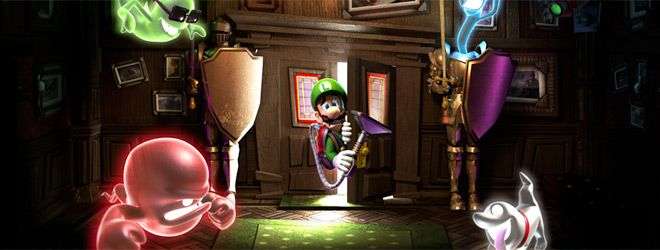






There are no comments, yet.
Why don’t you be the first? Come on, you know you want to!